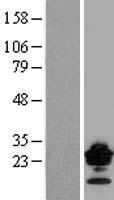Claudin 9 (CLDN9) (NM_020982) Human Tagged ORF Clone
CAT#: RC208701
- TrueORF®
CLDN9 (Myc-DDK-tagged)-Human claudin 9 (CLDN9)
"NM_020982" in other vectors (6)
Specifications
| Product Data | |
| Type | Human Tagged ORF Clone |
| Tag | Myc-DDK |
| Symbol | CLDN9 |
| Synonyms | claudin 9 |
| Vector | pCMV6-Entry |
| E. coli Selection | Kanamycin (25 ug/mL) |
| Mammalian Cell Selection | Neomycin |
| Sequence Data |
>RC208701 ORF sequence
Red=Cloning site Blue=ORF Green=Tags(s) TTTTGTAATACGACTCACTATAGGGCGGCCGGGAATTCGTCGACTGGATCCGGTACCGAGGAGATCTGCC GCCGCGATCGCC ATGGCTTCGACCGGCTTAGAACTGCTGGGCATGACCCTGGCTGTGCTGGGCTGGCTGGGGACCCTGGTGT CCTGCGCCCTGCCCCTGTGGAAGGTGACCGCCTTCATCGGCAACAGCATCGTGGTGGCCCAGGTGGTGTG GGAGGGCCTGTGGATGTCCTGCGTGGTGCAGAGCACGGGCCAGATGCAGTGCAAGGTGTACGACTCACTG CTGGCTCTGCCGCAGGACCTGCAGGCCGCACGTGCCCTCTGTGTCATTGCCCTCCTGCTGGCCCTGCTTG GCCTCCTGGTGGCCATCACAGGTGCCCAGTGTACCACGTGTGTGGAGGACGAAGGTGCCAAGGCCCGTAT CGTGCTCACCGCGGGGGTCATCCTCCTCCTCGCCGGCATCCTGGTGCTCATCCCTGTGTGCTGGACGGCG CACGCCATCATCCAGGACTTCTACAACCCCCTGGTGGCTGAGGCCCTCAAGCGGGAGCTGGGGGCCTCCC TCTACCTGGGCTGGGCGGCGGCTGCACTGCTTATGCTGGGCGGGGGGCTCCTCTGCTGCACGTGCCCCCC GCCCCAGGTCGAGCGGCCCCGCGGACCTCGGCTGGGCTACTCCATCCCCTCCCGCTCGGGTGCATCTGGA CTGGACAAGAGGGACTACGTG ACGCGTACGCGGCCGCTCGAGCAGAAACTCATCTCAGAAGAGGATCTGGCAGCAAATGATATCCTGGATT ACAAGGATGACGACGATAAGGTTTAA >RC208701 protein sequence
Red=Cloning site Green=Tags(s) MASTGLELLGMTLAVLGWLGTLVSCALPLWKVTAFIGNSIVVAQVVWEGLWMSCVVQSTGQMQCKVYDSL LALPQDLQAARALCVIALLLALLGLLVAITGAQCTTCVEDEGAKARIVLTAGVILLLAGILVLIPVCWTA HAIIQDFYNPLVAEALKRELGASLYLGWAAAALLMLGGGLLCCTCPPPQVERPRGPRLGYSIPSRSGASG LDKRDYV TRTRPLEQKLISEEDLAANDILDYKDDDDKV |
| Restriction Sites |
SgfI-MluI
Cloning Scheme for this gene
Plasmid Map

|
| ACCN | NM_020982 |
| ORF Size | 651 bp |
| OTI Disclaimer | Due to the inherent nature of this plasmid, standard methods to replicate additional amounts of DNA in E. coli are highly likely to result in mutations and/or rearrangements. Therefore, OriGene does not guarantee the capability to replicate this plasmid DNA. Additional amounts of DNA can be purchased from OriGene with batch-specific, full-sequence verification at a reduced cost. Please contact our customer care team at custsupport@origene.com or by calling 301.340.3188 option 3 for pricing and delivery. The molecular sequence of this clone aligns with the gene accession number as a point of reference only. However, individual transcript sequences of the same gene can differ through naturally occurring variations (e.g. polymorphisms), each with its own valid existence. This clone is substantially in agreement with the reference, but a complete review of all prevailing variants is recommended prior to use. More info |
| OTI Annotation | This clone was engineered to express the complete ORF with an expression tag. Expression varies depending on the nature of the gene. |
| Reconstitution | 1. Centrifuge at 5,000xg for 5min. 2. Carefully open the tube and add 100ul of sterile water to dissolve the DNA. 3. Close the tube and incubate for 10 minutes at room temperature. 4. Briefly vortex the tube and then do a quick spin (less than 5000xg) to concentrate the liquid at the bottom. 5. Store the suspended plasmid at -20°C. The DNA is stable for at least one year from date of shipping when stored at -20°C. |
| Reference Data | |
| RefSeq | NM_020982.1, NM_020982.2, NM_020982.3, NP_066192.1 |
| RefSeq Size | 2139 |
| RefSeq ORF | 654 |
| Locus ID | 9080 |
| Protein Families | Transmembrane |
| Protein Pathways | Cell adhesion molecules (CAMs), Leukocyte transendothelial migration, Tight junction |
| MW | 22.8 kDa |
| Gene Summary | This gene encodes a member of the claudin family. Claudins are integral membrane proteins and components of tight junction strands. Tight junction strands serve as a physical barrier to prevent solutes and water from passing freely through the paracellular space between epithelial or endothelial cell sheets, and also play critical roles in maintaining cell polarity and signal transductions. This protein is one of the entry cofactors for hepatitis C virus. Mouse studies revealed that this gene is required for the preservation of sensory cells in the hearing organ and the gene deficiency is associated with deafness. [provided by RefSeq, Jun 2010] |
Documents
| Product Manuals |
| FAQs |
| SDS |
Resources
Other Versions
| SKU | Description | Size | Price |
|---|---|---|---|
| SC322029 | CLDN9 (untagged)-Human claudin 9 (CLDN9) |
USD 420.00 |
|
| RG208701 | CLDN9 (GFP-tagged) - Human claudin 9 (CLDN9) |
USD 460.00 |
|
| RC208701L1 | Lenti-ORF clone of CLDN9 (Myc-DDK-tagged)-Human claudin 9 (CLDN9) |
USD 768.00 |
|
| RC208701L2 | Lenti-ORF clone of CLDN9 (mGFP-tagged)-Human claudin 9 (CLDN9) |
USD 768.00 |
|
| RC208701L3 | Lenti-ORF clone of CLDN9 (Myc-DDK-tagged)-Human claudin 9 (CLDN9) |
USD 768.00 |
|
| RC208701L4 | Lenti-ORF clone of CLDN9 (mGFP-tagged)-Human claudin 9 (CLDN9) |
USD 620.00 |
{0} Product Review(s)
Be the first one to submit a review






























































































































































































































































 Germany
Germany
 Japan
Japan
 United Kingdom
United Kingdom
 China
China



